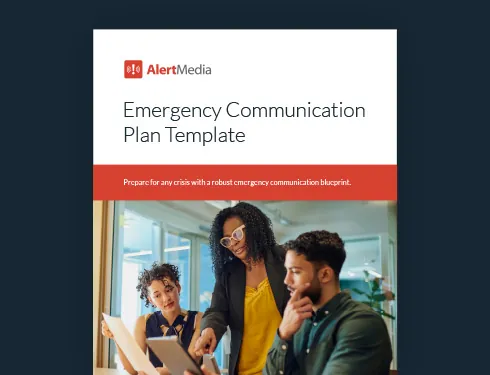
How a Crisis Communication Plan Supports Emergency Management
Crises can damage a business’s operations, harm its employees, and tarnish its reputation, but you can mitigate the impact. Learn what makes a good crisis communication plan and how it can help your organization.

So far, the 2020s have proven unpredictable and troublesome. The largest global pandemic in a century, political turmoil, natural disasters and environmental decline, and other dangers are forcing individuals and organizations to plan for things they didn’t even think of previously. This led to a difficult realization for many businesses: Their crisis communication plans weren’t sufficient to handle those events. In fact, a recent survey by Capterra showed that less than half of businesses have a formal crisis communication plan, and 23% have no plan at all.
Crisis management requires a mix of internal and external communication—to control the flow of information to outside observers and execute effective emergency procedures. Attempting to navigate a crisis situation without a clear communication plan puts your organization at risk of reputational damage, disruptions to business operations, and harm to your employees. In this post, we’ll discuss what crisis communication is, how it relates to overall crisis management, and the critical components you need to form a comprehensive crisis communication strategy.
Emergency Communication Plan Template
Basics of Crisis Communication
Crisis communication refers to the collection and dissemination of information related to an emergency or other situation. Effective crisis communication protects an organization’s business and reputation by providing context and consistent messaging around a particular issue or incident of public interest.
What is a crisis?
A crisis is any unexpected event that could potentially cause harm to your business’s operations or reputation. It can be caused by any sort of disaster scenario, such as natural disasters, financial issues, or cybersecurity breach. A crisis demands immediate attention and communication to mitigate negative effects. Most often, crisis communication responsibilities fall on public relations professionals for external concerns and HR for internal, operational, and customer-facing issues.
In recent years, organizations have increasingly incorporated crisis communication into overarching business continuity and emergency planning. This is due to the strategic—and urgent—nature of the work and the goal of aligning communication efforts with the organization’s overall emergency response plan.
Why Is Crisis Communication Important?
Most people have heard the adage, “news travels fast.” Research shows that “fake news” travels even faster.
In 2018, researchers at the Massachusetts Institute of Technology studied an estimated 126,000 news stories shared on Twitter. They found false or fabricated news stories were 70% more likely to be retweeted than true stories.

During times of crisis, there’s a near-instantaneous and insatiable desire for information, which puts pressure on organizations to use all available communication channels to set the record straight. A well-designed crisis communications plan can help eliminate confusion by clearly outlining how the business responds to the event. A crisis communication plan also helps counter the spread of misinformation before it has the opportunity to trigger real-world consequences.
Beyond information handling, crisis communication helps protect your people and your operations. It offers clarity and direction to key stakeholders and can even inspire increased confidence in the organization. Clear communication with stakeholders during emergencies and critical events strengthens business continuity by ensuring those involved in incident response understand what is needed to resolve the issue when it happens.
What Is a Crisis Communication Plan?
A crisis communication plan is a documented set of procedures and messages that enables your organization to respond to a crisis with speed and accuracy. When an organization encounters a sudden event—whether it’s a physical accident, a publicity issue, or anything else—this plan kicks into action, guiding the organization to take control of the chaos.
When a business encounters an emergency, it’s normal for people to feel confused. Who knows more? What caused this? How do we remedy this? How does this affect the organization and my position here? These are all questions you need to be able to answer confidently, quickly, and uniformly, all of which can be accomplished with a crisis communication plan.
How communication supports overall crisis management
Safety-focused companies are no strangers to ideas like all-hazards preparedness and scenario-specific emergency planning, such as fire evacuation routes and procedures. Being prepared for emergencies requires awareness, vigilance, and careful documentation to ensure teams are ready to act to remedy any crisis situation.
When an emergency materializes, you need a plan to respond immediately to that event. But in high-stress situations, people can forget even the best-laid plans under stress.
Imagine that a gas leak has been detected at your workplace. You prioritize getting everyone out of the building immediately, but in the commotion, your facilities manager forgets to engage the exterior gas shutoff valve, leaving your office unsafe for longer than if the proper procedures were carried out.
In this case and others like it, when you build reminders of proper procedures into your crisis communication plan, you can ensure critical tasks are completed quickly and in the right order. In the case of a gas leak, a solid plan would have specified that an emergency alert should immediately prompt employees to evacuate and another alert should prompt the assigned group—including the facilities manager—to initiate the emergency response plan, ensuring gas shutoff.
Crisis communication plan scenarios
Here are a few examples of when you might need to deploy your crisis communication plan. You’ll determine your specific risks in step one below.
- Natural disasters
- Product recalls
- Cybersecurity/data breaches
- Workplace accidents
- Health and safety issues
- Environmental incidents
- Supply chain disruptions
- Technological failures
- Social unrest/protests
Real-life crisis communication plan examples
These real crisis situations show what communication looks like during different disasters so you can understand how to communicate better during a disaster situation or PR nightmare.
The USSR’s downplaying of the Chornobyl disaster
On April 26, 1986, reactor number four at the Chornobyl Nuclear Power Plant near Pripyat in Ukraine was undergoing a planned safety test. When that test was delayed by the local energy authority, many workers were confused by a shift change and other variables. That, combined with malfunctioning or disabled safety controls and long-term suppression of scientific concern over the design of the RBMK-type reactors used at Chornobyl, led to the most significant nuclear accident in history.
As anyone who’s studied the history of this event—or watched HBO’s Chernobyl miniseries—knows that this tragedy could have been minimized or even averted with proper communication:
- The status of emergency controls should have been reported
- The timing of the test should have been confirmed by internal and external stakeholders
- Soviet nuclear scientists’ concerns should have been taken seriously and resolved
- Residents of towns and other countries in danger of exposure to radiation and fallout should have been alerted and evacuated as soon as the danger was identified
It is impossible to say exactly what would have happened to the Chornobyl reactor had these steps been codified into an authoritative communication plan. The toll of human life and illness is highly disputed, but it’s hard to imagine that proper communication protocols wouldn’t have lessened the catastrophic impact.
Procter & Gamble’s rapid response to the “Tide Pod Challenge”
In early 2018, news reports emerged about an internet trend called the “Tide Pod Challenge.” The social media trend involved someone (typically teenagers) filming themselves biting into one of the laundry detergent pods to document their reactions.
Soon after the trend reached mainstream news coverage, spokespersons for the American Association of Poison Control Centers and the U.S. Product Safety Commission issued statements reiterating the dangers of ingesting the chemicals contained in these products.
- In response to the crisis, Procter & Gamble, which counts Tide among its portfolio of brands, quickly operationalized its crisis communication plan, producing a wide range of content across social media and other communication channels to reiterate what to do—and not do— with its products, likely preventing countless injuries and lasting brand damage.
7 Steps to Develop Your Crisis Comms Plan
“We are constantly promoting preparedness and finding ways to engage our teams. Crisis preparedness is part of our DNA. You can’t let your emergency plans sit and collect dust. Having an active program is essential to keeping employees safe.”Penny Neferis Director of Business Continuity, Disaster Recovery, and Emergency Response, JetBlue Airways
A lack of preparation will result in more damage to your business and your reputation, above and beyond the disaster’s impact. The following seven steps will ensure you have an airtight plan for effective communication in any crisis scenario.
Step #1: Document possible crisis scenarios
You may not be able to predict the exact crisis your business will encounter or when it will happen, but you can pull together a list of possible emergency situations based on knowledge of your business and what similar organizations have faced in the past. For instance, your product or service may encounter an issue or an outage necessitating a recall or mass refund. If your organization is located in a hurricane-prone area, you’ll need a crisis communication plan geared toward a natural disaster. If your CEO decided to retire unexpectedly, you’ll need to have a plan lining up action steps to maintain business continuity.
Spend some time thinking through all plausible crisis scenarios and how you’d respond. A business threat assessment is a great way to systematically accomplish this analysis for a full range of potential threats.
PRO TIP: Use our Threat Assessment Template to structure your own custom review!
In an episode of The Employee Safety Podcast, Penny Neferis, Director of Business Continuity, Disaster Recovery, and Emergency Response at JetBlue Airways, discussed how brainstorming potential threats helps JetBlue’s crisis and emergency management teams practice their response. She explains, “We are constantly promoting preparedness and finding ways to engage our teams. Crisis preparedness is part of our DNA. You can’t let your emergency plans sit and collect dust. Having an active program is essential to keeping employees safe.”
By proactively identifying what crises could occur, you can be prepared to respond effectively if and when they strike.
Step #2: Monitor for emerging crises and threats
Once you’ve documented potential business risks and threats to your organization, you need a way to monitor them. Ensure your internal business continuity, security, and critical communications teams have documented processes and procedures for identifying, evaluating, and escalating emerging threats using open source intelligence and other public sources. If your organization doesn’t already have a security operations center (and even if you do), assess the business case for investing in a modern threat intelligence solution capable of alerting your internal teams of incidents as they occur.
Step #3: Assemble a crisis communication team
Create a task force of people from across your organization you can call on to help respond to a crisis. Assign each person a designated role, and include representation from HR, marketing, PR, legal, and the head of your organization’s emergency response. Include at least one member from the C-suite as they’ll likely serve as your primary spokesperson and should be kept up to date on all decisions and actions.
Step #4: Prepare company spokespeople and employees
After a high-profile crisis, it’s likely that reporters, community members, and other parties will be interested in learning more. Only authorized people should handle these requests to ensure the fidelity of the company’s message.
Depending on the size of your organization, you may want to have more than one company spokesperson. At least one C-suite executive should be prepared to speak publicly about the crisis. You also need to select one or more trusted faces at the company to act as internal spokespeople to relay information from leadership, field questions and concerns, and provide support and assurance.
Each spokesperson should also understand the company’s key messaging and predetermined communication goals for the crisis. Train your spokespeople to deliver statements with empathy and remind them to be authentic. They should speak clearly and know how to stay on message, and at least one should be available at any point until the crisis is resolved.
Additionally, prepare employees who may receive questions about the crisis from customers, partners, or the media. It’s a good idea to leverage your company’s internal communication system to reiterate your company’s social media policy and rules of engagement for responding to external requests. Consider providing customer-facing employees with pre-approved language to answer the most common questions.
Step #5: Identify key stakeholders
Consider the people and groups who may be affected by a crisis. This includes both internal and external audiences, including employees, investors, customers, and the general public. Once you have a good idea of the number of people who need to be addressed and informed, tailor your message accordingly. The message you send to employees should not be the exact message you send to customers. Consider the details each group needs to understand the situation and act appropriately.
Step #6: Integrate into your emergency preparedness plans
Many crises, such as those with the potential to do physical harm, will require emergency management in addition to crisis communication. Ensure you include emergency preparedness in your crisis communication plan steps (and crisis communication in your emergency preparedness steps). Consider at what point in a crisis you may require the safety and security team’s assistance, and make sure you’re aligned on overall goals. Your emergency preparedness team will likely already have a communication plan in place for employees, so if you’re communicating with external audiences as well, you may be able to use the same emergency notification system to get the message out.
Step #7: Assess, analyze, and update
Once the crisis passes, reconvene as a team for postmortem analysis. Rate your company’s overall performance in response to the event and determine what to improve for future scenarios. Update your crisis communication plan to account for that feedback and be better prepared if it happens again.
Crisis Communication Best Practices
To successfully navigate a crisis, be ready to make quick decisions, align with multiple stakeholders, and coordinate team members’ efforts across the business. While every scenario is different, the following crisis communication protocol best practices will help you coordinate your response—from pre-crisis planning through post-crisis follow-up—to avoid as much disruption to your business as possible when developing your crisis management plan.
Take immediate action
When an emergency occurs, you have to react quickly to remedy those problems. When a hazard is detected, your first priority should be notifying everyone who may be impacted to get them to safety and prevent others from wandering into harm’s way. As if that weren’t enough, you also have to worry about external forces.
With 24/7 media coverage, social media channels, and the ability to share information instantaneously, a crisis demands immediate communication on your part to cut through the noise and help stakeholders refocus on what is known. Even if you don’t have all the details, prepare a holding statement to reassure everyone (employees, customers, press, regulators, etc.) you’re aware of the issue and working to resolve it. Be clear and concise and provide a timeline of when you’ll be able to share another update. Often, simply acknowledging you’re aware of the issue will be enough to ease the anxiety of your employees, customers, regulators, the news media, and your community.
Never take a back seat
In response to a crisis, the worst thing a company can do is nothing. Failing to provide details to your people and the public will appear defensive and may result in key audiences thinking you’re at fault. It also gives other actors the opportunity to control the narrative to their own ends. Instead, be honest and upfront about the facts as you know them. Make sure attribution for your public statements reinforces who is taking charge of the situation internally. If you’re still awaiting more information, provide clarity about the timeline so interested parties know what to expect and when.
Set up listening and communication systems
It doesn’t matter if your team has the communication skills of Abraham Lincoln if they don’t have a way to broadcast their messages. One of the most important elements of any communication plan is a quality two-way emergency communication system so you can disseminate information to your employees while also receiving information from them about emerging situations needing your attention. Of course, collecting contact information like cell phone numbers is required for this to work.
PRO TIP: These systems can be used for internal day-to-day business communication as well. Employees will be more familiar with the system and what to expect if they are using it regularly.
To ensure you have a pulse on any feedback or commentary shared across social media and other external channels, set up a listening and monitoring system. This involves delegating specific people to comb through social media channels, watch the news, and flag any critical items.
Reach out to your safety and security team to also lean on the organization’s threat intelligence and risk monitoring capabilities. Early identification of a threat will give you more time to prepare and help you understand the impact on your people and locations.
Be transparent and authentic
When crafting any response, remember to be human. If you adopt a more corporate, neutral tone, it may come off as uncaring. Instead, be genuine and transparent, admit if you made a mistake, and convey a desire to make things right or resolve things quickly. Nothing will destroy trust in your company or your brand quicker than a response that demonstrates a lack of care or understanding.
Control the narrative with crisis communication
As expert communicators, PR professionals who specialize in crisis management play a critical role in ensuring both internal and external audiences receive timely, accurate, and relevant information. While it’s common for organizations to designate crisis management teams to spearhead these efforts, a 2021 study found that 95% of business leaders feel their crisis management skills need improvement.
In Timothy Coombs’s Situational Crisis Communication Theory (SCCT), he outlines four distinct approaches to crisis response:
- Rebuild: Take responsibility, apologize, and rebuild your relationship with your key stakeholders.
- Diminish: Minimize responsibility by justifying your actions or offering excuses.
- Deny: Place the blame elsewhere or claim there is no crisis.
- Bolster: Remind stakeholders of former good deeds.
Crisis Communication Sample Templates
Every communication plan should be unique to the organization, but here are a few examples of crisis communication templates that are adaptable for crisis comms plans.
Responding to a rogue spokesperson
We’ve explored why it’s critical to channel all public inquiries into a business crisis to trained spokespeople, but occasionally other employees are compelled to speak out on their own. They might misrepresent your company’s position and spread misinformation or express views your organization does not support. Here’s an understanding and firm response that is meant to be deployed as the first step in such a situation.
Sample message:
“We are aware of the comments made by one of our employees on/through [source of the comments/reporting]. [Your organization’s name] wants to make it clear that [relevant claim] is inaccurate and that the situation is, in fact, [correcting facts]. We apologize for the confusion and invite anyone to visit [website or another official source of info] for the latest updates on our efforts to remedy the situation. We appreciate the understanding of our customers, employees, and community during this time.”
Someone is injured due to company activities
Despite our best intentions, accidents can and do happen. When they do, you need to take responsibility for them. Trying to deflect blame or pass the buck never works out in the long run.
In this example, we’re imagining that a driver employed by a delivery contractor ran a stop sign and injured a group of pedestrians. Your company is well-recognized within the community, and attention has started building following the incident. You’ve already reached out to the victims and are offering support. Here’s one appropriate response you might use to comment on the situation and reassure the public that you’re working to make things right.
Sample message:
“[Your company] is shocked that one of our delivery vehicles [overview of injuries]. Safety is our top priority, and the driver in this incident has been terminated. We are committed to assisting authorities in investigating the accident and helping the victims and their families recover.
The largest part of our driver training program is devoted to safety, but clearly, that is not enough. We will implement automated driver safety controls in our vehicles to prevent any mistakes, boost our training to increase driver awareness, and conduct careful reviews of driving performance to identify problematic activity as soon as it occurs.
This event has rocked [company name] to its foundation, and we cannot express in words how heartbroken we are for the victims and their loved ones. Please reach out to [relevant authorities] if you have any information that might help their investigation.”
Take Control of Any Situation With Proactive Communication
The number and severity of crises facing organizations will continue to increase. By taking immediate action and following the guidelines shared above, your organization will be more than ready to respond and recover. A crisis communication plan can help you significantly mitigate any potential damage and keep your organization’s reputation intact. Above all else, remember to act quickly, communicate clearly, and be human.




![6 Steps to Creating an Effective Emergency Response Plan [+ Template]](https://www.alertmedia.com/wp-content/uploads/2023/10/Blog-Emergency-Response-Plan.webp)
